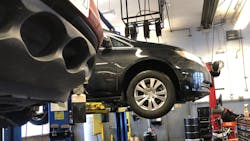In the past, you've heard me speak about how our habits either help or hinder the results we see on a daily basis. The minutiae of our day-to-day tends to blind us a bit. We see what's right in front of us and tend to bypass the greater perspective of what's around us.
Throughout the past few years, one of the top challenges facing owners has been the technician shortage. While it's true that the average age of the ASE-certified technician has dropped significantly over the past few years as a result of many technicians retiring their sore hands and backs, that's only part of the story.
Wages, another important topic, are also a significant part of the equation. While we as owners and managers have paid attention to exactly how much wages have gone up, we likely haven't paid attention to exactly how much cost of living has gone up.
In almost every tire dealership, the lowest-paid vehicle service employee is likely the general service technician. What's interesting is that this position is almost always the one that we stand to gain the most from on a regular basis, since employees in this position see the largest percentage of vehicles.
With proper processes and procedures — mainly rock-solid vehicle inspections — they stand to help find the services that consumers should know about to help maintain their vehicles and boost shop revenue. Sadly, these are also the employees most affected by the cost of living increases we're enduring. Let's discuss.
Based on data from the 300-plus rooftops in our 20 Groups, the average base hourly rate is $16.57 an hour. Most of these employees also get some sort of spiff. Let's say with spiffs they end up at $19 an hour. Some, if not most, get a few hours of overtime each week — let’s say 45 hours. In this example, their monthly gross pay is $3,907 and after taxes, they bring home around $2,930. On an annual basis, that's $35,170 to live on.
Now let's look at some conservative cost of living estimates. Let's say a one bedroom goes for $1,400 a month, transportation costs $500, healthcare $300, food $400, phone $100, internet $100 and utilities $200. These conservative estimates put a bare minimum cost of living at $3,000 a month. That's without any actual "niceties," like gym memberships, streaming services, nights out with friends and family, clothes, savings and incidentals.
The fact that a large majority of our employees who are taking care of our customers’ second largest investment, their vehicles, are maybe able to live month to month — if they're super frugal — should be a very hard pill for us to swallow.
Now, I'm definitely not saying you should simply give raises. That has happened a ton over the last few years and it's negatively affected payroll as a percent of gross profit because it wasn't directly tied to production. However, we should be encouraged to find ways to give our team members a chance to get ahead of the cost-of-living curve.
Do your employees have performance bonuses that are tied to your dealership’s primary profit drivers? Do they have the training available to get the skills they need to help improve your dealership’s productivity? Do they truly understand their pay programs and the behaviors they need to exhibit in order to maximize their earnings? Do you review these with them regularly? Do they have 75% or more control over the things that affect their income?
If the answer to any of these is no, you've got some things to think about in order to separate your dealership from competitors who never take the time to understand how we either are or aren't helping our team members get ahead in life.
Pay isn’t everything until it prevents us from being able to do most anything that makes life fun and enjoyable. After all, we're a team and helping each other succeed should be a top priority.





